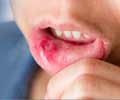
In healthy people, the result may be cold sores or fever blisters. In people with compromised immune systems, HSV-1 can pose more serious and chronic health problems.
It can spread, for example, to organs like the brain, lungs and liver, where the infection may become life-threatening. Some patients, such as those with atopic dermatitis - a common form of eczema that accounts for roughly 20 percent of all dermatologic referrals, are especially vulnerable to serious complications stemming from an HSV-1 infection.
Led by principal investigator Richard L. Gallo, MD, PhD, professor of medicine and chief of UC San Diego's Division of Dermatology, the scientists found that HSV-1 launches an infection by binding to receptors on the surface of skin cells. Ordinarily, if a cell recognizes the virus as an invader, an immune response is immediately triggered, which includes a group of proteins called scavenger receptors that help identify and remove harmful viruses.
But sometimes the process goes awry. While studying HSV-1 and scavenger receptors in cultured human skin cells, Gallo and colleagues in the Atopic Dermatitis Research Network, funded by the National Institute of Allergy and Infectious Diseases, discovered that the virus strongly interacts with a particular receptor called a macrophage receptor with collagenous structure or MARCO, which it uses to gain entry into cells.
In tests comparing mice expressing normal levels of MARCO with mice genetically engineered to lack the receptor, the scientists found that MARCO enhanced the virus' ability to infect cells. Mice lacking the receptor suffered dramatically smaller skin lesions than normal mice with normal levels of MARCO.
Advertisement
The research suggests that development of new therapies preventing HSV-1-MARCO interaction may measurably reduce the degree and risk of serious HSV-1-related complications in atopic dermatitis patients and others. The scientists plan to follow up with testing in atopic dermatitis patients, and investigate whether other skin viruses also use the same infection pathway.
Advertisement
Source-ANI













